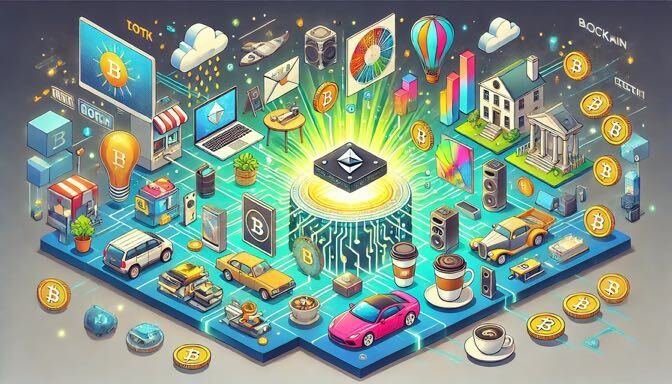The question “what is blockchain?” has been gaining increasing popularity in the digital world, especially when discussing Bitcoin and other cryptocurrencies. But what exactly is blockchain, and why has this technology become so essential in recent years?
Its impact can already be seen across various industries, including finance, healthcare, education, and governance. More than just a technological innovation, blockchain offers the opportunity to create fairer, more secure, and accessible systems for everyone.
In this article, we’ll cover what blockchain is, explaining its concept, how it works, its main benefits, and its many real-world applications. We’ll also answer common questions about this technology, providing clear examples and insights to illustrate why this technology is one of the most significant innovations of the 21st century.
What is Blockchain?
Blockchain can be thought of as a massive digital ledger where all transactions are securely, transparently, and immutably recorded.
Unlike traditional systems where a single entity, like a bank, controls information, blockchain operates through a decentralized network of computers distributed worldwide. This means no single organization has exclusive control, making the system more secure and reliable.
Originally created in 2008 as the foundation for Bitcoin, blockchain has since evolved into a technology with applications across multiple industries, including supply chain management, healthcare, and digital identity verification. For instance, in logistics, blockchain can be used to track a product’s journey from manufacturer to consumer, ensuring transparency and authenticity throughout the supply chain.
Example of Blockchain in Action
Imagine a simple example: You buy a coffee and pay with Bitcoin. This transaction is recorded in a block, containing details such as the amount paid, the digital address of the buyer, and the seller.
The transaction is then validated by multiple computers on the network, confirming that the payment is legitimate and that the buyer has sufficient funds. Once validated, the block is added to the chain, where it remains permanently recorded—accessible for verification but impossible to alter. This is a practical illustration of how blockchain works in everyday transactions.
Another example comes from the healthcare industry. Imagine your medical records are stored on a blockchain. This allows authorized doctors to access your history securely and efficiently, reducing the risk of data loss or manipulation. Since all updates are recorded and visible, the integrity and privacy of your data are ensured. This technology lowers administrative costs, improves efficiency, and increases trust in systems handling sensitive information.
The History and Origins of Blockchain
The concept of blockchain emerged in 2008 as the technological backbone of Bitcoin, the first cryptocurrency created by Satoshi Nakamoto. The goal was to develop a decentralized and secure system for financial transactions without relying on intermediaries. Since then, blockchain technology has evolved, finding applications far beyond cryptocurrencies.
How Does Blockchain Work?
Each transaction on a blockchain is grouped into a block, which functions like a page in this massive digital ledger. Each block contains transaction data, a unique identifier called a hash (which acts like a digital fingerprint to ensure integrity), and a link to the previous block via its hash. This structure forms a secure and continuous chain—the blockchain.
Before a new block is added, it must be validated by participants in the network through a consensus mechanism. Methods like Proof of Work (PoW) (used by Bitcoin) and Proof of Stake (PoS) (used by Ethereum) ensure that only legitimate transactions are recorded, protecting the system against fraud and errors.
Once added to the chain, a block becomes virtually immutable. For example, if someone attempts to alter a recorded transaction, the change would invalidate the entire chain, making any tampering evident. This immutability is one of the reasons why blockchain is considered so secure.
Additionally, blockchain is transparent—anyone can verify recorded transactions using blockchain explorers. At the same time, privacy is maintained through cryptographic methods that protect user identities with anonymous addresses.
This combination of security, transparency, and decentralization makes blockchain a revolutionary technology with applications beyond cryptocurrencies, such as medical data management and electronic voting systems.
The Basic Structure of Blockchain
Blockchain functions as a digital ledger composed of interconnected blocks. Each block contains:
- Verified transactions, permanently recorded.
- A timestamp marking when operations took place.
- A unique hash, which acts as a digital signature for the block.
- The hash of the previous block, ensuring a secure and connected chain.
How Blockchain Works
- Distributed Network: Blockchain doesn’t rely on a central entity like banks. Instead, it’s maintained by a network of globally distributed computers (nodes) that validate and share information, eliminating intermediaries and enhancing security.
- Consensus Mechanisms: To add a new block, network participants must agree on the validity of transactions. This is done through consensus mechanisms like PoW or PoS, depending on the blockchain network.
- Cryptography: All blockchain data is protected by encryption algorithms, ensuring security while maintaining user anonymity.
The Process of Blockchain Transactions
- Transaction Creation: A user initiates a transaction, which is digitally signed using their private key, ensuring authenticity and ownership of the funds.
- Network Broadcasting: The transaction is sent to the blockchain network, where it joins a pool of pending transactions.
- Validation: Miners or validators check the transaction for authenticity, ensuring the sender has sufficient funds and preventing double-spending.
- Inclusion in a Block: Once validated, the transaction is grouped into a new block containing a list of approved transactions.
- Block Addition: The block is added to the blockchain after being verified through the consensus mechanism.
- Transaction Confirmation: As more blocks are added, the transaction gains more confirmations, making it increasingly secure and irreversible.
How Does Blockchain Mining Work?
Blockchain mining is an essential process to ensure the secure and efficient operation of decentralized networks such as Bitcoin and other cryptocurrencies. This process involves validating and recording transactions in blocks, which are then added to the chain, ensuring the integrity and immutability of the blockchain. Let’s explore the details of how Bitcoin mining works, explaining how it operates and its importance.
What is Blockchain Mining?
Blockchain mining is the mechanism through which new blocks are created and added to the chain while transactions are verified and confirmed. In networks that use Proof of Work (PoW), such as Bitcoin, mining is carried out by computers competing to solve complex mathematical problems. These computers, called miners, perform two main functions:
- Transaction validation: They verify if the transactions sent to the network are legitimate and follow established rules, such as checking whether the sender has sufficient funds.
- Creating new blocks: They group the verified transactions into a block, solve a mathematical problem to validate it, and add it to the chain.
How Does the Mining Process Work?
Mining is the process that validates and records transactions on a blockchain, ensuring the security and operation of the network. Here’s how it works in simple terms:
- Pending Transactions: When someone sends a cryptocurrency, the transaction is broadcast to the network and placed in a “pool” of pending transactions, waiting to be validated.
- Transaction Selection: Miners choose which transactions to include in the next block. Typically, they prioritize transactions with higher fees, as these fees are part of the reward they receive.
- Solving Mathematical Problems: To validate the block, miners need to solve a complex mathematical challenge called hashing. This involves finding a specific number (nonce) that, combined with the block data, creates a unique code called a hash. This process requires multiple trial-and-error attempts.
- Proof of Work: When a miner solves the challenge, they share the solution with the network. Other miners verify whether the solution is correct. This ensures that everyone in the network agrees that the block is valid.
- Recording on the Blockchain: After validation, the block with the transactions is added to the blockchain. This makes the information permanent and immutable.
- Miner’s Reward: The miner who solves the problem receives a reward called block reward. This reward includes newly created cryptocurrencies and the transaction fees from the block.
Practical Example
Imagine you send Bitcoin to a friend. Your transaction enters the pool of pending transactions, gets validated by a miner who solves the mathematical problem, and is then recorded in a new block on the blockchain. This block becomes a permanent part of the network, and the miner is rewarded for their work.
Generally, Bitcoin mining is done using specialized equipment such as ASICs. However, it is still possible to mine Bitcoin via mobile devices through mining pools.
Importance of Mining
Mining plays a crucial role in the security and functionality of the blockchain. It ensures that:
- Transactions are legitimate: Only valid transactions are recorded, protecting the network against fraud.
- The network remains decentralized: No single entity controls the entire process, reinforcing trust and resistance to censorship.
- New coins are created: Mining is the method by which new units of cryptocurrency enter circulation, in networks like Bitcoin.
How Does a Blockchain Transaction Work?
Transactions on a blockchain operate in a decentralized manner, ensuring security, transparency, and efficiency without the need for intermediaries like banks. This process follows well-defined steps that involve the creation, validation, and recording of data on the chain. Let’s explore each phase in a simple and practical way.
Transaction Creation
When a person initiates a blockchain transaction, they specify details such as:
- The sender’s address.
- The recipient’s address.
- The amount to be transferred.
- Transaction fees (incentive for miners or validators to process the transaction).
These details are then digitally signed by the sender using their private key. This signature ensures that the transaction is authentic and that only the owner of the sending address can authorize the use of the funds.
Transmission to the Network
Once created, the transaction is sent to the blockchain network. It is propagated among the nodes (participating computers) and added to a pool of pending transactions, awaiting validation.
Transaction Validation
The transaction must be validated to ensure that:
- The sender has sufficient balance.
- There are no attempts to spend the same funds more than once (double-spending prevention).
Depending on the blockchain’s consensus mechanism (such as Proof of Work or Proof of Stake), miners or validators check the transaction’s authenticity. If the criteria are met, the transaction is included in a block along with other pending transactions.
Block Inclusion
Once validated, the transaction is recorded in a block. This block contains:
- A list of transactions.
- A timestamp (record of when it was created).
- A hash (unique identifier for the block).
- The hash of the previous block in the chain.
These elements connect all blocks on the blockchain, ensuring that any attempt to alter a transaction would invalidate the entire subsequent chain.
Adding the Block to the Blockchain
After the block is validated, it is added to the blockchain. This makes the transaction immutable and visible to any network participant, ensuring complete transparency.

Transaction Confirmation
When the block containing the transaction is added to the blockchain, it receives its first confirmation. The more blocks added after the transaction’s block, the more secure it becomes. In networks like Bitcoin, it is common to wait for 3 to 6 confirmations to ensure irreversibility.
Finalization
The recipient can verify the transaction on the blockchain using tools like blockchain explorers. This way, they know that the funds have been sent and are permanently recorded.
Practical Example: How to Buy with Bitcoin
Imagine you buy a coffee and pay with Bitcoin. Here’s how the process works:
- You scan the store’s QR code, which contains the digital address where the funds will be sent.
- Using your cryptocurrency wallet, you enter the coffee’s price and confirm the transaction. Your private key signs the operation.
- The transaction is sent to the network and, within minutes, gets validated and included in a block.
- After a few confirmations, the café owner sees that the payment has been recorded and considers the transaction complete.
This process ensures secure and verifiable transactions without the need for a central authority.
Blockchain and Cryptocurrencies
What is blockchain in the context of cryptocurrencies?
Blockchain serves as the technological foundation for the functioning of cryptocurrencies. It acts as a decentralized digital ledger that permanently and immutably records all transactions made with digital currencies. This technology eliminates the need for intermediaries, such as banks, allowing peer-to-peer transactions with high security and efficiency.
The role of blockchain in cryptocurrencies
Transaction recording
Each cryptocurrency transaction, such as Bitcoin or Ethereum, is recorded in a block. These blocks, connected in a continuous chain, ensure that all movements are stored transparently and can be verified by any network participant.
Example: When you send Bitcoin to another person, the transaction is validated by the network, recorded in a block, and added to the blockchain. This creates a permanent and accessible record.
Security and immutability
Blockchain uses advanced cryptography to protect transaction data. Once a transaction is recorded, it cannot be altered or deleted, ensuring integrity and trust in the network.
Because of this, cryptocurrencies are less susceptible to fraud or manipulation, unlike centralized financial systems.
Decentralization
Cryptocurrencies operate on decentralized networks, meaning no single entity controls the system. Blockchain distributes power among network participants (nodes), eliminating intermediaries and promoting financial independence.
Practical example: Instead of a central bank controlling Bitcoin, it is managed by a global network of computers that validate and record all transactions.
Proof of ownership
Blockchain allows users to prove they own a certain amount of cryptocurrency without revealing personal information. This ownership is verified through digital signatures, enhancing user privacy.
Issuance of new coins
For many cryptocurrencies, such as Bitcoin, blockchain is also used to issue new monetary units through processes like mining. This ensures that coin creation is controlled and follows predefined rules.
Smart contracts
Some blockchains, like Ethereum, allow the creation of smart contracts. These contracts execute automatically when certain conditions are met, revolutionizing sectors such as decentralized finance (DeFi).
Example: A smart contract can automatically release a payment once a service is delivered, eliminating the need for intermediaries.
Why is blockchain essential for cryptocurrencies?
Without blockchain, cryptocurrencies would not have the trust, security, and decentralization that make them so attractive. It ensures that:
- Transactions are fast and secure, without relying on intermediaries.
- There is transparency since anyone can verify the transaction history.
- A decentralized structure is maintained, reducing costs and increasing accessibility.
Blockchain: What is it and why is it important?
Throughout this article, we explored the question: What is blockchain, how does it work, and why has this technology revolutionized various sectors? We have seen that blockchain is a decentralized, secure, and transparent system capable of recording transactions permanently and immutably. With applications ranging from cryptocurrencies to healthcare, education, and governance, blockchain stands out as one of the most important innovations of the 21st century.
Understanding what blockchain is not only helps to comprehend the world of cryptocurrencies but also opens doors to identifying new opportunities in different industries. The technology offers a promising future, enabling the creation of fairer, more accessible, and more reliable systems.
We invite you to continue exploring the world of blockchain and discover how it can transform the way we live, work, and interact. The potential of blockchain is immense, and being informed is the first step to taking advantage of everything this technology has to offer.





